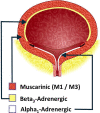Neurogenic bladder - concepts and treatment recommendations
- PMID: 34156189
- PMCID: PMC8932021
- DOI: 10.1590/S1677-5538.IBJU.2021.0098
Neurogenic bladder - concepts and treatment recommendations
Abstract
Introduction: Bladder and urinary sphincter malfunctioning that results from some change in the central and/or peripheral nervous system is defined as neurogenic bladder. The urinary tract symptoms that can be related to its filling, emptying, or both have a significant impact on the quality of life of individuals. The present review was based on the document prepared for the public health system in Brazil as a treatment guidelines proposal.
Material and methods: Survey questions were structured as per PICO (Population, Intervention, Control, and Outcome). Search strategies were defined and performed in the MEDLINE/Pubmed, Embase, Epistemonikos and Google Scholar databases. The selection of articles followed the evidence hierarchy concept; evidence body was identified, and the quantitative study data were extracted. The quality of evidence and grade of recommendation were qualitatively assessed according to GRADE (Grading of Recommendations, Assessment, Development and Evaluations).
Results: A total of 2.707 articles were identified, with 49 of them being selected to compose the basis for this review. Neurogenic bladder treatments were classified according to their focus on filling or emptying symptoms and sub- classified in pharmacological and surgical treatments.
Conclusion: Treatment guidelines are important tools for the public health system to promote the best practice when treating neurogenic bladder patients.
Keywords: Therapeutics; Urinary Bladder, Neurogenic; Urinary Sphincter, Artificial.
Copyright® by the International Brazilian Journal of Urology.
Conflict of interest statement
None declared.
Figures




References
-
- Blok B, Castro-Diaz D, Del Popolo G, Groen J, Hamid R, Karsenty G, et al. Summary of European Association of Urology (EAU) Guidelines on Neuro-Urology 2020. [Internet]. Available at. <https://uroweb.org/guideline/neuro-urology/> - PubMed
-
- [No Authors] Urinary Incontinence in Neurological Disease: Management of Lower Urinary Tract Dysfunction in Neurological Disease. In: National Clinical Guideline Centre (UK). Royal College of Physicians. London (UK); Published by the National Clinical Guideline Centre. 2012; vol 1. pp. 47-311. - PubMed
-
- Panicker JN, Fowler CJ, Kessler TM. Lower urinary tract dysfunction in the neurological patient: clinical assessment and management. Lancet Neurol. 2015; 14:720-32. - PubMed
-
- Madersbacher H. The various types of neurogenic bladder dysfunction: an update of current therapeutic concepts. Paraplegia. 1990; 28:217-29. - PubMed
Publication types
MeSH terms
LinkOut - more resources
Full Text Sources
